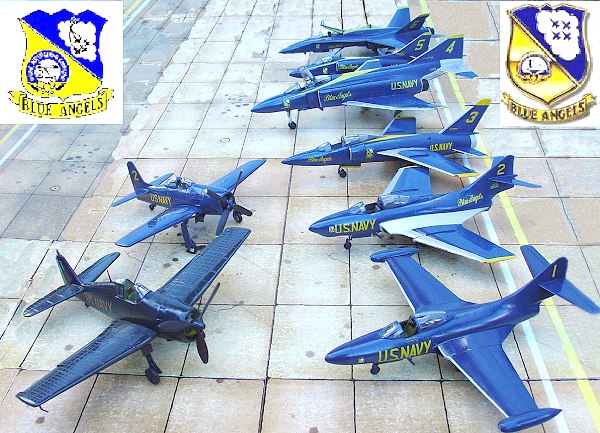
| KITS: | MPC F6F-5 Hellcat; Monogram F8F Bearcat; Minicraft/Hasegawa F9F-2 Panther; Minicraft/Hasegawa F9F-8 Cougar; Minicraft/Hasegawa F11F-1 Tiger; Mini-craft/Hasegawa F4J Phantom II; Minicraft/Hasegawa A-4F SkyHawk; Hasegawa F/A-18A Hornet. |
| KIT #: | Minicraft/Hasegawa 1209; Minicraft/Hasegawa SP135:3600; AMT/ERTL 8228_Individual models: MPC 7007-70; Monogram PA144.70; Hasegawa D10:1000; Tamiya 60762.1300; Airfix 3022 |
| PRICE: |
Blue Angels History($39.99); F6F-5 Hellcat (?); Monogram F8F Bearcat (?); |
| DECALS: | See article |
| REVIEWER: | Dan Hamilton |
| NOTES: | Wildly varying quality depending on production era of particular model |

| HISTORY |
“Friendly” inter-service rivalry, the peacetime promotion of our military and the recruiting of future soldiers are at the heart of the origin and history of both the United States Navy’s Blue Angels and United States Air Force’s Thunderbirds.
Origin of the Angels
In 1907 the United States Army was the first branch of service to establish an aeronautical division, but in 1912 it was the United States Navy that apparently first used warplanes to promote its mission at “air shows.” However the First World War accelerated the development and popularity of aviation and resulted in an explosion of air shows across the county. The American Navy’s motivation for its first official flight demonstration team began when Navy fighter squadron member D.W. Thomlinson attended a Spokane Washington air show in 1927 and saw the jaw dropping aerobatics of James “Jimmy” Doolittle and the graceful coordinated routine of the Army’s “Three Musketeers” flight demonstration team. These Army flyers had completely outclassed the Navy’s offering at Spokane -- three pilots who had apparently been chosen at random from three different squadrons. After training in secret in their squadron’s Boeing F2B-1 fighters, Thomlinson’s Navy team gave its first performance the next year during a San Francisco air show and was promptly dubbed the “Suicide Trio” by the press. Desiring to be masters of their own – more reassuring -- name, team members decided to call themselves the “Three Sea Hawks.” Other teams from other Navy squadrons soon followed under such names as the “High Hatters,” the “Three Gallant Souls” and the nautically appropriate “Three Flying Fish.” The Second World War, however, put a temporary end to Navy demonstration teams – good pilots were needed elsewhere.
After World War Two ended, the Navy renewed its recruiting strategy to a war weary nation and sought to extend their search for potential recruits even into landlocked middle America far removed from coastal bases. This time, however, the idea for an aerial demonstration team began not at the individual squadron level but at the top – either the Secretary of the Navy (according to some historians) or Chief of Naval Operations Admiral Chester Nimitz (according to the Navy’s official history). Lieutenant Commander Roy M. “Butch” Voris – a decorated fighter ace with seven victories to his credit – was chosen to form and train the Navy’s new flight demonstration team. In addition to recruiting new sailors and showing the public the Navy’s colors, Voris admitted the new squadron’s mission -- like that of the very first Navy team decades earlier – was to “beat the Army; then it was the Army Air Forces.” To do that, he later recalled, they would “have to put a little risk into this thing” and “give them [the Army] something to jump at.” Voris hand picked the men to fly and maintain the team’s planes – all bachelors because: “We were not going to worry about children at this stage of the game.”
The first flight of the Navy’s “Flight Exhibition Team” was on May 10, 1946 and its first show was held on June 15, 1946 at Jacksonville Florida. The highlight of their routine was the shooting down of a “Zero” – actually a SNJ trainer that would set off a smoke bomb, eject a dummy pilot filled with sand and then dive to disappear behind some obstacle. Only later did they name themselves “The Blue Angels” -- reflecting the color of their Navy planes and borrowing from a classy New York nightclub called the “Blue Angel” which Voris’ wing man had read about in a New Yorker article.
| THE KITS |
 In my naive way, I started this
project thinking all I needed was to win an E-Bay auction for the 1970’s
era and out of production Minicraft/Hasegawa “Blue Angels History in
Miniature” set. It had five planes used by the Blues from the 1950’s
through the 1970’s in 1/72 scale. (A newer Hasegawa set adds the
present fighter but then deletes one of the earlier planes the older
set had included). After getting the old set, the only thing needed to be
complete would be the easily obtained model and decals for the team’s
current mount that they began flying in the 1980’s … right? NOPE! The
Blues started flying in the 1940’s and have actually flown eight
different aircraft as part of their formation flying: the “history” set
(the old and the new) lacked their first two planes -- the Hellcat and
Bearcat. What follows is a brief description of my overall approach to
building the Angels’ planes, a summary history of their use and the
construction and challenges -- some met better than others – each kit
posed.
In my naive way, I started this
project thinking all I needed was to win an E-Bay auction for the 1970’s
era and out of production Minicraft/Hasegawa “Blue Angels History in
Miniature” set. It had five planes used by the Blues from the 1950’s
through the 1970’s in 1/72 scale. (A newer Hasegawa set adds the
present fighter but then deletes one of the earlier planes the older
set had included). After getting the old set, the only thing needed to be
complete would be the easily obtained model and decals for the team’s
current mount that they began flying in the 1980’s … right? NOPE! The
Blues started flying in the 1940’s and have actually flown eight
different aircraft as part of their formation flying: the “history” set
(the old and the new) lacked their first two planes -- the Hellcat and
Bearcat. What follows is a brief description of my overall approach to
building the Angels’ planes, a summary history of their use and the
construction and challenges -- some met better than others – each kit
posed.
| CONSTRUCTION |
Because from their inception the Blue Angels numbered each team plane with an appropriate sequential digit painted on its tail, I thought this would be a convenient device to also show the chronological order of the different aircraft they used (i.e. “1” would be their first plane the Hellcat, “2” would be their second the Bearcat, etc.) The problem was that the Blues have flown eight planes over the years (not counting the F7U-1 Cutlass which was a maintenance nightmare, never flown as part of the formation demonstration team, used for only a few months as a side act in the 1952 season, and – most importantly -- for which no model in 1/72 scale could be found), and I could find no evidence the Blues had any formation flight team plane with any higher number on its tail than “7” -- and the current “7” is a “two seater“ for public relations use. Indeed some early Angel transport planes, such as the Douglas R5D-3 and Lockheed Constellation, were identified with tail number “8.” Accordingly, I built the Hellcat and Bearcat as plane numbers “1” and “2” (being the first and second types of piston driven aircraft they flew) and started over for the Blues jets from 1949 to the present. Yes, my family would say such obsessiveness is “madness” – but hey, at least there is a “method” to it.
Grumman F6F-5 Hellcat: 1946
In 1946 the Angels were allowed
to choose from the following available Navy fighters: FM-2 (a General
Motor’s built F4F Wildcat), F4U Corsair, F6F Hellcat and F7F Tigercat.
Voris chose the plane he flew in the war -- the F6F-5 Hellcat -- but
because of the on-going “draw down” of forces during that early post-war
period, he was forced to use refurbished Grummans that had already been
through their operational cycle. Voris however had them modified to reduce
their excess weight by removing such non-essentials as guns, armor and ammo
boxes. Because blue and gold are the Navy’s colors, Voris chose to paint
the planes either insignia blue (according to Voris’ recollection) -- or a
“semi gloss sea blue” (according
 to other authoritative sources) -- and
used actual gold leaf for the “US (no periods) Navy” written on the
fuselage sides and the lower half of their wings, as well as for the
individual team number on the tail and the appropriate Bureau number. Each
plane was then highly polished and waxed to an impressive shine.
to other authoritative sources) -- and
used actual gold leaf for the “US (no periods) Navy” written on the
fuselage sides and the lower half of their wings, as well as for the
individual team number on the tail and the appropriate Bureau number. Each
plane was then highly polished and waxed to an impressive shine.
From my father’s kit collection I had inherited an old MPC F6F Hellcat model that had an option to be built as the appropriate “-5” variant (supposedly a different engine cowling and canopy from that of the F6F-3), so it was perfect. Well, not really. Actually, it’s a terrible model. Ill-fitting seams and wing joints, absent cockpit and surface detail as well as something the instructions called “wing plugs” – stumpy substitutes for landing gear – were all a product of this early era of kit development. My project was turning out to be “historical” in more than just its subject matter. However, I am sure a master modeler could make this into an acceptable representation. Unfortunately, I am not a “master” modeler. My final Hellcat product is both a great disappointment and the worst plane of the project. A good second market set of “Blue Angels” F6F decals would have gone a long way to improve it – and a set did exist once (i.e. Super Scale 72-217), but apparently had been long out of production and so precious no modeler was willing to rob his stash to sell it on e-bay. Even then, from web reviews the commercially available decals did not appear to have been gold leaf colored as accuracy required. Accordingly, I had to settle for tracing in Testor’s gold enamel (#1144) the compatible decals that came with the model. Finally, as with all the Blue Angels models, the Hellcat was finished with Model Masters Gloss Clear Lacquer overcoat (#1961).
To me at least, accuracy together with proper execution makes a good model. In my execution of the Blue’s first mount, I find solace only in attempted accuracy. If I ever run across a good 1/72 F6F-5 with Blue Angels decals – this one is toast.
Grumman F8F Bearcat: 1946-1949
In August of 1946 the Blues
apparently had sufficiently proven their worth that the brass approved
their transition to the Navy’s then front line, lighter and more powerful
F8F Bearcat fighter. Unlike the refurbished F6Fs they had been flying for
six months, the Angels pilots this time flew directly to Grumman’s Bethpage
factory, did their last Hellcat show for the workers, and flew off with
their freshly painted Bearcats. Their new planes’ overall paint scheme was
changed to a special shade of blue (FS15050), while a unique yellow-gold
paint (13538) replaced the gold leaf previously used for their insignia –
which now had periods after the “U” and the “S” that preceded the “Navy”
emblazoned on their fuselages and on the undersides of their wings. Though
it came too late to have fought in World War Two (the first F8F squadron
was assigned to the carrier Langley but failed to make it into combat
before the War ended in August of 1945), by 1947 the Navy would be
operating 23 squadrons of Bearcats. Its only actual combat use
however would be in South East Asia by other countries -- France, Thailand
and S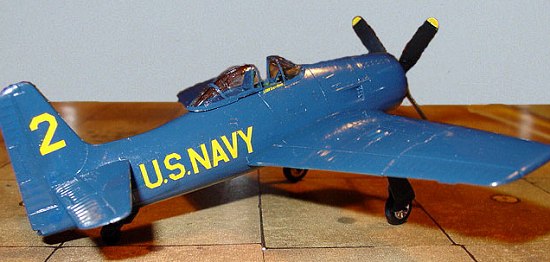 outh Vietnam.
It was the last of Grumman’s great piston driven fighters and the Blues
would fly it for the next three years. However, it also was the first
plane -- but unfortunately not the last -- in which an Angels pilot would
die. On September 29, 1946, at an air show at their home field in
Jacksonville Florida, a wing tip snapped off while an F8F was performing a
“Cuban 8 with a double roll” causing it to crash and kill its pilot
Lieutenant Robby Robinson.
outh Vietnam.
It was the last of Grumman’s great piston driven fighters and the Blues
would fly it for the next three years. However, it also was the first
plane -- but unfortunately not the last -- in which an Angels pilot would
die. On September 29, 1946, at an air show at their home field in
Jacksonville Florida, a wing tip snapped off while an F8F was performing a
“Cuban 8 with a double roll” causing it to crash and kill its pilot
Lieutenant Robby Robinson.
My model of the Blue’s second make of aircraft again came from my inherited model collection, but was somewhat more developed on the evolutionary ladder of model making technology – Monogram’s F8F Bearcat produced in 1967 (about the year I started making models with my dad). The simplicity of the model is demonstrated by the fact the instructions consisted of a single illustration with minimal directions printed on one side of single sheet. However, the fit was far better than the Hellcat, with little filling at important points such as the wing roots and a bit more, though still primitive, cockpit detail (i.e. there was actually a joy stick and instrument panel, sort of). My research could uncover no currently available decals depicting the Blues’ Bearcat (though after I had built it I learned a set could be purchased after all -- Super Scale Decals 720642). Having learned my lesson with the Hellcat insignia, rather than try paint I instead bought yellow decals from Aero Master (#72-167) containing “45 degree ID numbers and letters” which allowed me to assemble Blue Angels insignia that turned out passably well. The obvious paint choice for this -- and all Blues planes that followed -- was Model Master “Blue Angels Blue” (4687) and “Blue Angels Yellow” (4684). Because the Angels’ aircraft were constantly cleaned and polished, painting did not include weathering and offered few challenges -- spray paint on blue as a base coat, slap on the decals, touch them up with yellow and spray with a gloss overcoat.
Grumman F9F-2 (“-5” variant was later used) Panther: 1949-1954
The F9F-2 was the first jet
used by the Navy in the Korean War and, for many, it is forever linked to
one of the best movies about that war -- “Bridges at Toko-Ri.” The Blues’
use of the Panther however began back in May of 1949, prior to that “police
action,” and just a month after the F9F had first been delivered to
operational squadrons. Indeed, the aircraft was so new the Angels had to
build their own support equipment. Further, the Angels quickly learned
their new higher speed planes prevented the show from being performed as
close to the audience as they had flown the slower piston driven Hellcat
and Bearcat. When the Korean War started the following year, the Chief of
Naval Operations decided the Blues should participate and in July of 1950
they gave their last show before shipping overseas. On March 8, 1951, the
Blues leader -- Lieutenant Commander Johnny Magda -- was killed when his
F9F was hit by anti-aircraft fire while he was attacking
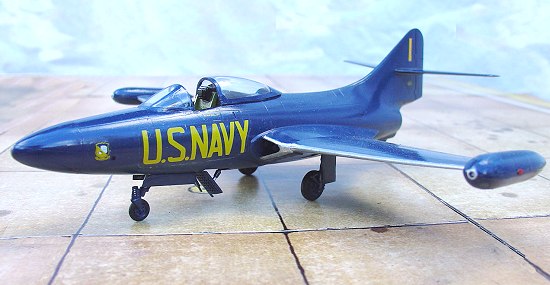 the bridges at the Hwachon Dam. He was the first Blues commander killed during combat and
apparently an inspiration for Michener’s novel “Bridges at Toko-Ri.”
During the squadron’s second tour, the Navy actually shipped two or three
of the Blues’ original Panthers with them. Later, the Blues as a
demonstration team were reformed under their original commander Voris in
June of 1952 and started flying the more powerful F9F-5 Panther. However,
the same year of its reformation, several Angels Panthers collided while
performing the four plane diamond formation causing the death of Blues
pilot Bud Wood. Nevertheless, within two weeks, the Angels were back
performing.
the bridges at the Hwachon Dam. He was the first Blues commander killed during combat and
apparently an inspiration for Michener’s novel “Bridges at Toko-Ri.”
During the squadron’s second tour, the Navy actually shipped two or three
of the Blues’ original Panthers with them. Later, the Blues as a
demonstration team were reformed under their original commander Voris in
June of 1952 and started flying the more powerful F9F-5 Panther. However,
the same year of its reformation, several Angels Panthers collided while
performing the four plane diamond formation causing the death of Blues
pilot Bud Wood. Nevertheless, within two weeks, the Angels were back
performing.
In the same way the real F9F-2 was a dramatic evolution from the F8F, so too Hasegawa’s Panther contained in the “Blue Angels History In Miniature” set was a step up the evolutionary ladder from Monogram’s 1967 era Bearcat. No recessed panel lines yet, but the cockpit had improved (e.g. along with a joy stick, the ejection seat now looks something like the real thing and the instrument panel and switches are at least attempted to be illustrated by decals), the wheel wells at least had some detail, the fit was good, and it even allowed for the airbrakes to be put in the open position. A little lead weight in the nose worked wonderfully to keep the Cougar on its tricycle landing gear and avoid it becoming a tail dragger. Though I’ve read some reviews critical of the decals for the kit (with which I concur as to some of the later Blues planes in the set), those for the Angels’ version of the Panther seemed perfectly acceptable to my uninformed eye. Further, in that the Blue Angels “set” obviously was simply an amalgam of various prior individually sold Hasegawa kits, the accompanying decals included not just the “Blue Angels Panther 1949 Pensacola,” but also a plane assigned to the Marine‘s “VMF-115 1953, Spring, Korea” and one that flew with the Navy‘s “VF-123.” I’m beginning to learn how helpful it is to have a decals stash.
Grumman F9F-8 Cougar: 1955-1956
The Cougar was essentially a
variant of the Panther with swept wings (to minimize the shock wave caused
by speeds approaching the “sound barrier”) and a “flying tail” (to maximize
control at those higher speeds), a more powerful engine (which allowed
those higher speeds and required a lengthened fuselage) but without its
characteristic wing tip tanks. The F9F-8 also had a dump valve in its
wingtips, which allowed the Angels to add a new feature to their
acrobatics: they dyed the planes’ fuel and released it at strategic points
during their routine. This achieved the desired result of an impressive
colored 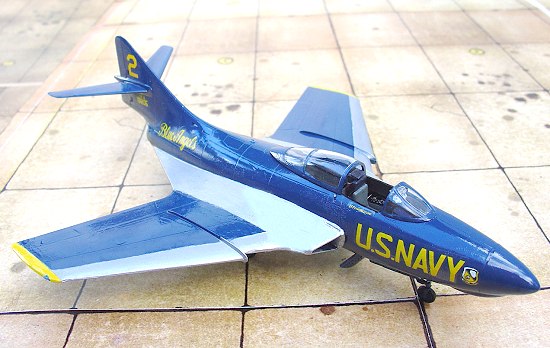 contrail tracing the path of the formation during its acrobatics.
This also achieved the undesired result of spreading highly combustible and
toxic vaporized jet fuel on the crowd. Their maintenance crew chief would
later devise the simple solution of pumping smoke oil through a copper pipe
running down the outside the plane’s fuselage ending at the exhaust nozzle
and thereby accomplish the same effect without jeopardizing the masses with
a petroleum mist hazard.
contrail tracing the path of the formation during its acrobatics.
This also achieved the undesired result of spreading highly combustible and
toxic vaporized jet fuel on the crowd. Their maintenance crew chief would
later devise the simple solution of pumping smoke oil through a copper pipe
running down the outside the plane’s fuselage ending at the exhaust nozzle
and thereby accomplish the same effect without jeopardizing the masses with
a petroleum mist hazard.
Assembling Hasegawa’s Cougar was not much different from constructing the Panther. However, the Blue Angels’ F9F-8 had noticeably more bare metal area on the wing’s leading edges and over the length of the engine intakes than did the F9F-2. The base blue coat was spray brushed on and then Testers’ silver (#1146) was brushed on for the supposedly “unpainted“ and polished aluminum surface. With the larger metallic area being shown, I realized afterwards how much more obvious brush strokes can be. By the time I got to the Thunderbird project my supposed masking “skills” improved (i.e. I actually tried it, with various frustrating results) because I had no choice -- the Air Force’s early team planes were almost completely bare metal. However, at this early point in the project I lived with the silver brush strokes for the Angels planes. As with the Panther, the Cougar’s decals also included insignia for two aircraft flown by operational squadrons: VF-81 and VT-26. As with the Panther, the Angels’ decals were not very flashy nor did they pose much difficulty. Nevertheless, the many various yellow insignia, serial numbers and informational stencils looked good against the glossy “Blue Angels” blue finish.
Grumman F11F-1 Tiger: 1957-1968
Just before the Blues’ new
leader Ed Holly took command in 1957, he had witnessed an Air Force
Thunderbird show demonstrating the capabilities of their supersonically
capable F-100 SuperSabre “and the noise it put out.” He concluded the
Angels’ Cougar had become too long in the tooth: the Navy team needed an
aircraft capable of flying the speed of sound too. As Holly later
explained, Grumman’s supersonic F11F “was a stronger airplane than the
F9F-8, but the burner was the main reason for going to it. The
afterburner’s noise was a crowd pleaser.” (Having attended air shows
growing up in the late 1960’s and early 70’s, I have to agree. Just as the
spine of a World War Two buff tingles when a classic war bird’s piston
engine is heard coughing to life and then starting to purr, watching a jet
fighter suddenly go vertical, hearing the boom of its
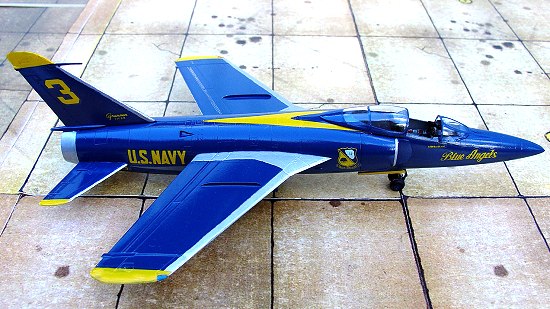 afterburners and
seeing yellow flames come out of an exhaust nozzle is a primordial blue
collar pleasure not to be denied.) The power of the Tiger allowed the
Blues show to become more vertical than horizontal and thereby remain
within the area of the airfield. The next year, in an air show attended by
the Air Force General Curtis LeMay, the Navy team introduced its
“back-to-back pass” where two planes fly straight and level down the flight
line but the lower fighter is right side up and the plane above it is up
side down. (Supposedly the proud LeMay threw his ever present cigar down
and yelled “I don’t believe this!”) Though over time three team members --
Commander Nick Glasgow, Lieutenant Commander Dick Oliver and Lieutenant
Frank Gallagher -- would be killed flying the F11F in separate accidents,
the team continued to fly this last Grumman Angels mount for over a
decade. Indeed, the Blues flew the Tiger far longer than it had ever been
in operational use with the Navy.
afterburners and
seeing yellow flames come out of an exhaust nozzle is a primordial blue
collar pleasure not to be denied.) The power of the Tiger allowed the
Blues show to become more vertical than horizontal and thereby remain
within the area of the airfield. The next year, in an air show attended by
the Air Force General Curtis LeMay, the Navy team introduced its
“back-to-back pass” where two planes fly straight and level down the flight
line but the lower fighter is right side up and the plane above it is up
side down. (Supposedly the proud LeMay threw his ever present cigar down
and yelled “I don’t believe this!”) Though over time three team members --
Commander Nick Glasgow, Lieutenant Commander Dick Oliver and Lieutenant
Frank Gallagher -- would be killed flying the F11F in separate accidents,
the team continued to fly this last Grumman Angels mount for over a
decade. Indeed, the Blues flew the Tiger far longer than it had ever been
in operational use with the Navy.
Because the Angel’s Tiger was the first to use a more elaborate yellow trimmed paint job, the decals were more of a challenge to apply. This was particularly true as to the elongated arrowhead on the undercarriage. Hasegawa’s F11F kit -- like all subsequent models in the “Blue Angels History” set -- did not provide decals for operational units. Far better, however, the decals instead included all the options for the Blues’ tail numbers including the stenciled names of various pilots and their respective plane’s corresponding serial numbers. My plan for the set dictated that the Tiger be depicted as number “3” (the third chronological jet flown by the Angels). Coincidentally, this was also the plane in which Lieutenant Commander Oliver was killed during a 1966 fatal Toronto air show accident. This allowed the F11F model also to be a memorial to one of the Angels lost in the line of duty.
McDonnell-Douglas F4J Phantom II: 1969-1973
When the Blues were looking for
a new plane to replace the aging F11F, America was deeply involved in the
Vietnam War. Accordingly, the Navy at first was not amenable to supplying
the team scarce front line fighters from its depleted inventory. Again,
inter-service rivalry guided the Blue’s history and provided the brass the
necessary incentive. As the team’s Leader Bill Wheat later explained: “The
way we got the F-4 was that we had heard the Air Force was going to get
them” so he argued up the chain of command that it was not fair the
Thunderbirds alone should have the Phantom: it had originally been designed
for the Navy and it was the Navy which had first deployed it. In response,
the Navy quickly found six “lead nosed” F-4’s (which were being used
exclusively for carrier qualifications and had ballast in the nose rather
than weapons and other combat equipment). With the increase in power of
the big aircraft, the Blues were able to go through their familiar
maneuvers in less time and thereby add more routines to the same 22 minute
air show. However, the extra
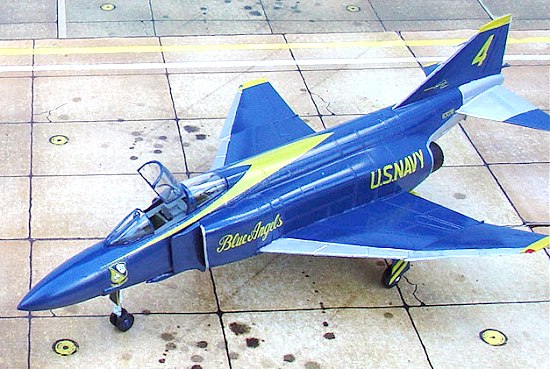 power also had its drawbacks: during a
British Columbia air show one of the pilots unintentionally exceeded the
speed of sound and shattered windows for eight blocks around the Canadian
waterfront. Further, several accidents with the Phantoms occurred in later
years, resulting not only in various severe injuries but also the death of
Lieutenant Larry Watters in a 1972 solo accident and a fatal mid-air
collision the following year that killed Lieutenant Commander Skip Umstead,
Captain Mike Murphy and Petty Officer Ronald Thomas. These tragic
accidents and the energy crisis caused the remainder of the Angel’s 1973
season to be cancelled and the fuel guzzling F-4 to be abandoned as the
team’s plane.
power also had its drawbacks: during a
British Columbia air show one of the pilots unintentionally exceeded the
speed of sound and shattered windows for eight blocks around the Canadian
waterfront. Further, several accidents with the Phantoms occurred in later
years, resulting not only in various severe injuries but also the death of
Lieutenant Larry Watters in a 1972 solo accident and a fatal mid-air
collision the following year that killed Lieutenant Commander Skip Umstead,
Captain Mike Murphy and Petty Officer Ronald Thomas. These tragic
accidents and the energy crisis caused the remainder of the Angel’s 1973
season to be cancelled and the fuel guzzling F-4 to be abandoned as the
team’s plane.
Because the Phantom was the Blue Angel plane of my childhood (I still remember cupping my hands to my ears in shock as it unexpectedly thundered from behind the crowd during an air show), I was particularly eager to build it. Though the fit was good and posed just a few sanding difficulties, the lack of cockpit detail was a disappointment: regressing to a more primitive era of modeling, the cockpit was essentially a tub with molded on beefy ejection sheets. Further, the canopy was molded in the closed position requiring the old hot X-acto knife trick to separate it for it to be displayed in the open position like its sister aircraft. Finally, the slender and elongated yellow decals were frustrating to get properly applied to the complicated bulbous F-4 shape. This is where I became acquainted with Testor’s “decal solvent” (880901) and Microscale’s “Micro Set.” I am not really sure whether these products actually made any physical difference. Perhaps it was instead the therapeutic effect of repeatedly brushing them over the model that in time allowed me to actually position and fit the decals to the plane rather than tear them and wad them into a collective ball. Nevertheless, the F-4 is my sentimental favorite and looks threatening even in 1/72 scale.
McDonnell-Douglas A-4F Skyhawk: 1974-1985
Though the Skyhawk first flew
in 1954, it was still being produced (and would be for another five years)
when the Angels first began flying it. It had carried nuclear weapons
during the Cuban Missile Crisis, provided close ground support and
anti-aircraft suppression in the Vietnam War, was used by the Israelis in
the Yom Kippur War, and would later be used against the British in the Falklands
War and -- long after the Blues transitioned to another aircraft -- it was
still being used by the Kuwaiti Air Force in the first Gulf War. Indeed, though the
Navy recently retired it in 2003, a retired Blue Angel Commander has
assembled a squadron of A-4’s for his company that he hires out to provide
attacking “adversary” fighters to oppose current U.S. pilots in flight
training. In 1974, however, the Skyhawk was not the first or even second
choice of the Blues -- they had first
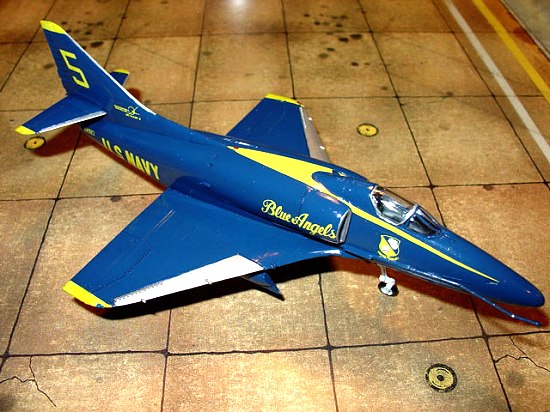 requested and been denied both the
F-14 and A-7. The A-4 was simply the only remaining fleet plane that would
work for the Angels. Nevertheless, the aging aircraft was affectionately
known as the “Scooter” because of its legendary maneuverability and ably
served the Blues for over a decade. After 12 years of that duty, however,
a mid-air collision during a show in 1985 killed Lieutenant Commander
Robert Gershon and sped up the transition to a more modern Angel mount in
1986.
requested and been denied both the
F-14 and A-7. The A-4 was simply the only remaining fleet plane that would
work for the Angels. Nevertheless, the aging aircraft was affectionately
known as the “Scooter” because of its legendary maneuverability and ably
served the Blues for over a decade. After 12 years of that duty, however,
a mid-air collision during a show in 1985 killed Lieutenant Commander
Robert Gershon and sped up the transition to a more modern Angel mount in
1986.
The Skyhawk undeniably well served the Blues and our nation’s defense for decades, yet to me it is the most ascetically unattractive plane they ever flew. Nevertheless, in the process of building the model I began to have a grudging respect -- dare I say affection -- for this little homely plane that can still out maneuver our most modern combat jets. This sentimentality arose despite the continuing lack of much cockpit detail -- though unlike the Phantom -- its ejection seat actually looked much more like the real thing, in a thick 1/72 kind of way. As with the Phantom, the clear part of the canopy was molded shut. However, this time the hot X-acto trick would not work: the structural remainder of the canopy had been molded into the fuselage. Hence, the A-4 is the only Angel plane in the set with a closed canopy. Further, its odd lines made the application of the now even more elongated yellow striping on the top of the fuselage even more difficult than it was for the Phantom. Though of questionable alignment, the decals finally somehow got in place -- just do not look too closely.
McDonnell-Douglas F/A-18A Hornet: 1986-present (Now the “Boeing” F/A-18 Hornet)
First flown in 1978, the Hornet
was designed as a “dual role” aircraft -- both interceptor and bomber.
Though capable of speeds just under Mach 2, the Hornet was engineered to
handle well at slow speeds for turning tight so as to get behind an
adversary in a dogfight. Accordingly, the F/A-18 was perfect for
demonstration team work and allowed the Angels to include new maneuvers in
their routine. In 1992, the Blues took a page from the Thunderbirds and
for the first time in decades visited Europe and for the first time ever
deployed to once “iron curtain” countries -- including a flight over of the
Kremlin itself! (The Navy was persuaded in favor of a European tour in
part by the manufacturer who wanted to show their product to both present
and future foreign buyers.) Going into its 20th year with the
Angels in 2005, the Hornet has the longest service record with the team of
any other formation plane and one of the best safety records.
future foreign buyers.) Going into its 20th year with the
Angels in 2005, the Hornet has the longest service record with the team of
any other formation plane and one of the best safety records.
In that all the other Blues jet models I built were from Hasegawa, it seemed fitting to conclude with their Hornet kit as well. Having done so, what a difference a few decades make! The F/A-18 kit was a dramatic contrast from the primitive MPC Hellcat model. For example the cockpit now includes an ejection seat that is much more like the full size version, the joy stick is back and relatively convincing decals make the instrument panels much more believable. The evolution to the much coveted recessed panel lines is now included and the cockpit not only can be made in the open position but includes a nice hydraulic strut that keeps it open. The one construction fault I found, perhaps due to my ham-handed model making skills, is the poor fit gotten when joining the two fuselage halves. Instead of the traditional left and right pieces, the kit has top and bottom pieces. This avoids the need to sand the seam that usually runs down the middle of the aircraft, but creates a new seam on the complicated sides that is highly difficult to reach in order to smooth out. The decals again helpfully provide the serial numbers, tail number and pilot names for each of the six individual planes in the squadron. My example was of course made as number “6” -- the sixth jet flown by the Angels. Again, however, the long thin yellow striping was the greatest challenge for this final Blues mount because it practically runs the entire length of the rolling fuselage and across complex surfaces -- including an open canopy. Again, don’t look to hard at the stripe alignment. (Just as a note of Interest, your editor had his retirement flag flown in Blue Angel #6 as part of his 'over, under and on the sea' theme for his retirement flag. Ed).
| CONCLUSIONS |
Though I am more proud of how some of the models turned out than I am about others, I am very satisfied with the overall impact of the project. The challenges were compensated for by the enjoyment of learning new things bout a massive subject. The beauty of this particular project is that it will never really be finished. When the team transitions to a new plane sometime in the future (the 25% larger F/A-18 E/F Super Hornet, or perhaps F-35 Joint Strike Fighter), I’ll be one of the first in line to buy the model and to order a larger display case for my set!
January 2005
| REFERENCES |
Books:
John M. Elliot, The Official Monogram US Navy & Marine Corps Aircraft Color Guide, Vol. 2 1940-1949, p. 183 (1998).
John M. Elliot, The Official Monogram US Navy & Marine Corps Aircraft Color Guide, Vol. 4 1960-1993, p. 196 (1993).
Nicholas A. Veronico & Marga B. Fritze, Blue Angels: 50 Years of Precision Flight, (1996)
Harry Gann, “The Douglas A-4 Skyhawk,” Aircraft in Profile Vol. 5, No. 102 (1969).
Hall Andrews, “The Grumman F8F Bearcat,” Aircraft in Profile Vol. 5, No. 107 (1969)
Magazines:
Graham Chandler, “The Hotrod Squad,” Air & Space Smithsonian (July, 2004)
Warren Thompson, “ “ Flight Journal (October, 2004)
Computer Discs:
21st Century Airplane Magic, Flight Demonstration Squadrons: Navy Blue Angels, Air Force Thunderbirds
Web sites:
Blue Angels Alumni Association www.blueangels.org/Aircraft/Master/Master.html#Panther
Official Blue Angels Site www.blueangels.navy.mil/flashindex.html
United States Navy Blue Angels www.navy.com/jsp/explore/comunity/blueangels/index.jsp?cid=28&pid=2
The Ejection Site www.ejectionsite.com/
Instrument Panels gra.midco.net/mlgould/A-F.html#Cougar
Cybermodeler Online: Aircraft Photo Walkarounds & References www.cybermodeler.com/resource1.shtml
Phil's Aeronautical Stuff: Aircraft Detail Photos www.philsaeronauticalstuff.com/aircraftdetailphotos.html
Aircraft Resource Center: Aircraft Walk Arounds www.aircraftresourcecenter.com/
Robert Lundin’s Aircraft Walk Around Center aircraftwalkaround.hobbyvista.com/
Highgallery: United States Navy Blue Angels http://www.highgallery.com/Navy-Blue-Angles.html
If you would like your product reviewed fairly and quickly by a site that has nearly 300,000 visitors a month, please contact me or see other details in the Note to Contributors.